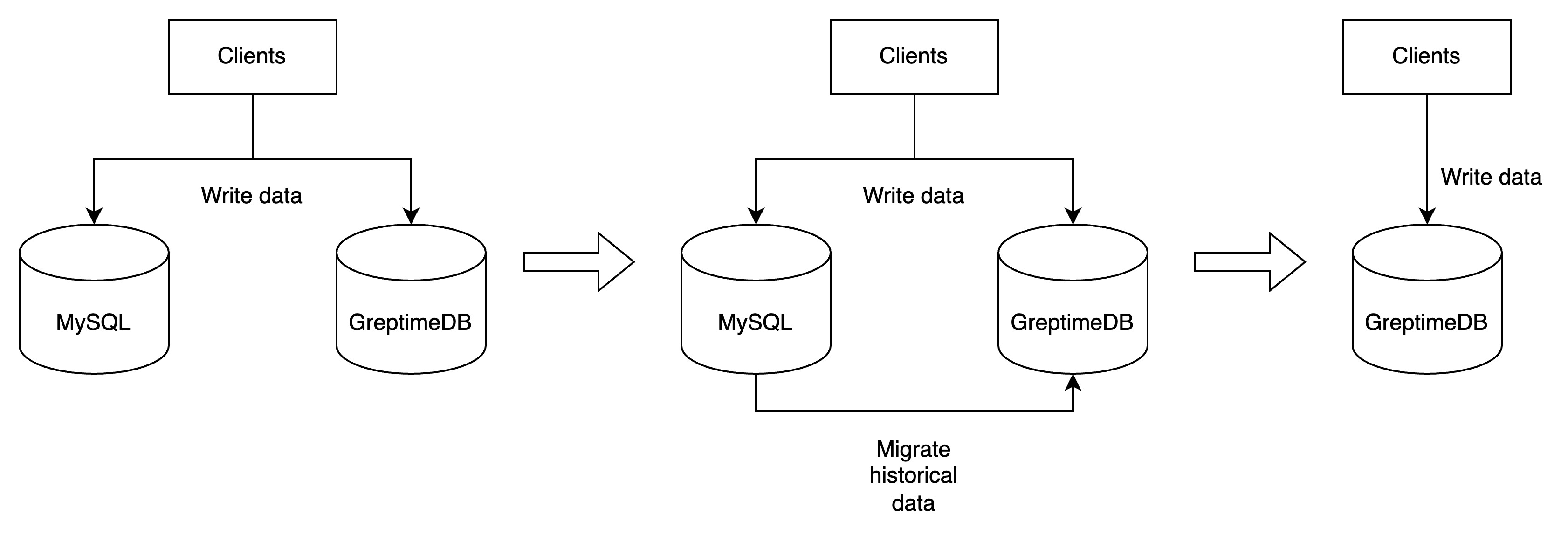Migrate from MySQL
This document will guide you through the migration process from MySQL to GreptimeDB.
Before you start the migration
Please be aware that though GreptimeDB supports the wire protocol of MySQL, it does not mean GreptimeDB implements all MySQL's features. You may refer to:
- The ANSI Compatibility to see the constraints regarding using SQL in GreptimeDB.
- The Data Modeling Guide to create proper table schemas.
- The Data Index Guide for index planning.
Migration steps
Create the databases and tables in GreptimeDB
Before migrating the data from MySQL, you first need to create the corresponding databases and tables in GreptimeDB. GreptimeDB has its own SQL syntax for creating tables, so you cannot directly reuse the table creation SQLs that are produced by MySQL.
When you write the table creation SQL for GreptimeDB, it's important to understand its "data model" first. Then, please take the following considerations in your create table SQL:
-
Since the time index column cannot be changed after the table is created, you need to choose the time index column carefully. The time index is best set to the natural timestamp when the data is generated, as it provides the most intuitive way to query the data, and the best query performance. For example, in the IOT scenes, you can use the collection time of sensor data as the time index; or the occurrence time of an event in the observability scenes.
-
In this migration process, it's not recommend to create another synthetic timestamp, such as a new column created with
DEFAULT current_timestamp()as the time index column. It's not recommend to use the random timestamp as the time index either. -
It's vital to set the most fit timestamp precision for your time index column, too. Like the chosen of time index column, the precision of it cannot be changed as well. Find the most fit timestamp type for your data set here.
-
Choose a primary key only when it is truly needed. The primary key in GreptimeDB is different from that in MySQL. You should use a primary key only when:
- Most queries can benefit from the ordering.
- You need to deduplicate (including delete) rows by the primary key and time index.
Otherwise, setting a primary key is optional and it may hurt performance. Read Primary Key for details.
Finally please refer to "CREATE" SQL document for more details for choosing the right data types and "ttl" or "compaction" options, etc.
-
Choose proper indexes to speed up queries.
- Inverted index: is ideal for filtering by low-cardinality columns and quickly finding rows with specific values.
- Skipping index: works well with sparse data.
- Fulltext index: enables efficient keyword and pattern search in large text columns.
For details and best practices, refer to the data index documentation.
Write data to both GreptimeDB and MySQL simultaneously
Writing data to both GreptimeDB and MySQL simultaneously is a practical strategy to avoid data loss during migration. By utilizing MySQL's client libraries (JDBC + a MySQL driver), you can set up two client instances - one for GreptimeDB and another for MySQL. For guidance on writing data to GreptimeDB using SQL, please refer to the Ingest Data section.
If retaining all historical data isn't necessary, you can simultaneously write data to both GreptimeDB and MySQL for a specific period to accumulate the required recent data. Subsequently, cease writing to MySQL and continue exclusively with GreptimeDB. If a complete migration of all historical data is needed, please proceed with the following steps.
Export data from MySQL
mysqldump is a commonly used tool to export data from MySQL.
Using it, we can export the data that can be later imported into GreptimeDB directly. For example, if we want to export
two databases, db1 and db2 from MySQL, we can use the following command:
mysqldump -h127.0.0.1 -P3306 -umysql_user -p --compact -cnt --skip-extended-insert --databases db1 db2 > /path/to/output.sql
Replace the -h, -P and -u flags with the appropriate values for your MySQL server. The --databases flag is used
to specify the databases to be exported. The output will be written to the /path/to/output.sql file.
The content in the /path/to/output.sql file should be like this:
~ ❯ cat /path/to/output.sql
USE `db1`;
INSERT INTO `foo` (`ts`, `a`, `b`) VALUES (1,'hello',1);
INSERT INTO ...
USE `db2`;
INSERT INTO `foo` (`ts`, `a`, `b`) VALUES (2,'greptime',2);
INSERT INTO ...
Import data into GreptimeDB
The MySQL Command-Line Client can be used to import data into
GreptimeDB. Continuing the above example, say the data is exported to file /path/to/output.sql, then we can use the
following command to import the data into GreptimeDB:
mysql -h127.0.0.1 -P4002 -ugreptime_user -p -e "source /path/to/output.sql"
Replace the -h, -P and -u flags with the appropriate values for your GreptimeDB server. The source command is
used to execute the SQL commands in the /path/to/output.sql file. Add -vvv to see the detailed execution results for
debugging purpose.
To summarize, data migration steps can be illustrate as follows:

After the data migration is completed, you can stop writing data to MySQL and continue using GreptimeDB exclusively!
If you need a more detailed migration plan or example scripts, please provide the specific table structure and data volume. The GreptimeDB official community will offer further support. Welcome to join the Greptime Slack.